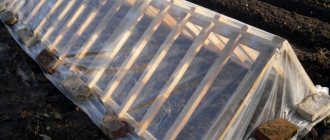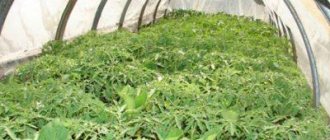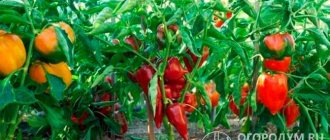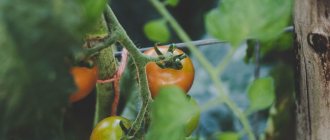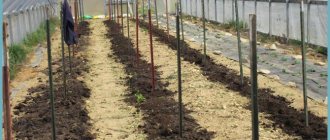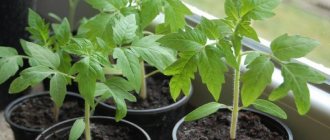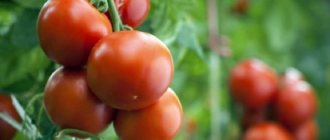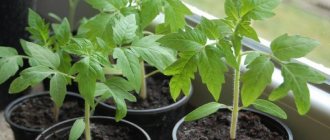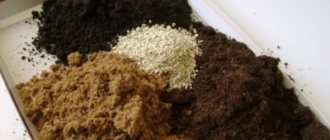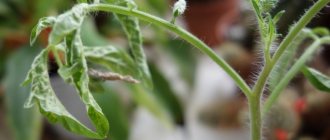Tomatoes are one of the most popular vegetables on the holiday and daily table. It's hard to imagine a summer/autumn table without tomatoes. They are used for cooking fresh and stewed, canned, stuffed. There are a huge number of recipes where tomatoes occupy the main place. Therefore, almost everyone who has a summer house, a vegetable garden, or a garden plot strives to grow a heat-loving crop on their own. Since the plant is heat-loving and, under unfavorable weather conditions, is unable to fully bear fruit, many summer residents grow tomatoes in greenhouses. It is with the help of a greenhouse that it is possible to preserve and increase the yield, protecting tomatoes from low night temperatures, wind, scorching sun, and heavy summer rains. Today, specialized stores offer the purchase of polycarbonate greenhouses. Place it in a sunny place. Growing tomatoes and getting the most out of them is not difficult, but there are still certain rules for cultivating a heat-loving plant. Growing tomatoes in a polycarbonate greenhouse is an activity accessible even to an inexperienced summer resident.
Soil for growing tomatoes
Professional breeders do not recommend using the same beds for growing tomatoes for several years in a row. The culture devastates the soil, and this leads to the emergence of infectious diseases. Until recently, tomatoes were grown in the place where cucumbers grew. But, unfortunately, today both cultures are susceptible to the same infection - anthracnose. The possibility of disease occurrence can be reduced if the soil is replaced and disinfected. For the procedure, use a solution containing copper sulfate: dilute 1 tbsp in 10 liters of settled water. l. drug. An excellent option for disease prevention is the removal of the top layer of soil: the soil at a depth of 10 cm is removed from the greenhouse and replaced with a new substrate.
Copper sulfate as a disinfectant only acts when hot. Optimal temperature indicators are 95-100 degrees. For the successful cultivation of tomatoes in a greenhouse, its use is extremely important.
To successfully grow tomatoes, it is necessary to prepare the place for planting the crop in advance. The ideal dimensions of the planting area are 25 cm high and 85 cm wide. Well-drained soil should be used. The soil should be as loose as possible and moderately moist. Tomatoes love space: row spacing should be at least 90 cm.
Tomatoes are not picky about soil composition. But still, gardeners recommend using loamy soil with the addition of peat, sawdust, and rotted manure for tomato plantings. The substrate is prepared in equal proportions. For 1 m2 of area, use 30 liters of loose and nutrient mixture. Peat substrate is also used for growing tomatoes in a greenhouse:
- peat;
- rotted manure;
- turf soil;
- river sand – 0.5 parts;
- 40 g of superphosphate, it is better to use a granular product;
- 20 g potassium sulfate;
- 20 g of potassium magnesia;
- 2 g sodium nitrate;
- 500 g wood ash.
Frost protection
There are several ways to combat return frosts. It is very important to preserve the seedlings in time, otherwise you may be left without a harvest. Many gardeners recommend creating greenhouse warmers using plastic bottles. As it cools, just add hot water. The containers are buried deeper into the ground; heated stones can also be used. All these options are suitable for emergency protection of seedlings.
You can install a metal container near the greenhouse and fill it with porous bricks, after soaking it in a flammable liquid. It is necessary to route a pipe from the tank to the upper part of the greenhouse. This will create a warm cloud. To save seedlings, insulation materials are also used - lutrasil or spanbod. There are those who prefer electric heaters; usually it is necessary to install 2-3 devices. When installing, it is important to take into account that warm air vapors do not directly fall on the seedlings; it would not hurt to additionally equip them with a temperature sensor and timer, which will allow you to automatically turn off and turn on the devices.
The most important thing when using flammable liquids and electrical appliances when heating a polycarbonate greenhouse is compliance with fire safety rules.
Choosing a variety: what you need to know for maximum productivity of tomatoes
In order to successfully grow tomatoes in a polycarbonate greenhouse, you need to choose the right crop variety. Hybrids are best suited. Such tomatoes are resistant to infectious and fungal diseases and are small in size. Tomatoes of determinate and semi-determinate varieties are suitable. Their peculiarity is the formation of only one stem. The growing season is 120 days. Before sowing seeds in a greenhouse, it is necessary to determine whether the plant can be cultivated in a closed space. Professional gardeners recommend that beginners plant low-growing tomatoes with a short growing season.
Choosing a tomato variety for growing in a greenhouse:
- Openwork, which has increased resistance to infections;
- A bourgeois with tasty fruit;
- Doll Masha – pink tomatoes with a high juice content;
- Major - sweet tomatoes that are used fresh, prepared in salads and juices;
- Octopus is the leader among tomatoes for greenhouse cultivation: versatile, tasty, aromatic.
Before buying tomato seeds, you need to decide on the purpose of obtaining the harvest. After all, one variety is suitable for salads, and another variety is suitable for pickling for the winter. The peculiarity of the variety affects the taste of tomatoes, their aroma and transportation of the harvested crop.
Several varieties can be grown simultaneously in a greenhouse. The culture fully develops in the vicinity of cucumbers. Self-pollinating varieties are suitable for growing tomatoes in a polycarbonate structure.
Selection of seed
A large assortment of seeds forces us to be careful when choosing seed not only for tomatoes, but also for other crops. There are a number of criteria that are worth paying attention to. First of all, it is endurance to various diseases, which are quite common in this culture. Not all varieties are suitable for obtaining a large harvest.
Depending on the use of future tomatoes, varieties are divided into categories: for salad, slices, pickles and preparations, tomato juice. Tomatoes also differ in taste. They can be sweet, sour, sweet and sour, fruity and even bitter. It is better to give preference to a well-known company with good reviews.
Special attention should be paid to the varieties of tomatoes - low-growing or tall with large, medium or small fruits. The packaging usually indicates what soil the seeds are intended for growing in: open ground or greenhouse. There are shrubs with a limited growing point. The fruits differ in color: red, green, yellow, and sometimes black; and also according to ripening periods - late, middle, early. Self-pollinating varieties are very popular among gardeners.
Transplanting
Tomatoes are very demanding of heat. Ideal soil temperatures are more than 13 degrees Celsius. As a rule, tomato seedlings are planted in a greenhouse in early May. Seedlings with a height of more than 40 cm with a formed peduncle take root best. When planting in a greenhouse, you should pay attention to the condition of each plant: only healthy individuals are planted in the greenhouse. If tall varieties of tomatoes are planted, then the distance between plants should be increased to 50 cm. For low-growing varieties, the distance can be reduced to 40 cm.
For tomatoes, it is very important to adhere to timely planting of seedlings. Overgrown plants produce lower yields.
Unstretched, strong plants are planted in a vertical position. Overgrown or elongated plants are planted with a certain slope, tearing off the leaves located below: they will interfere with deepening the crop. Tomatoes quickly form additional roots and gain strength. Seedlings are planted immediately after preparing the holes. To eliminate the infection, it is recommended to water the soil with prepared manganese: dilute 1 g of manganese in a bucket of fresh, settled water. Complex fertilizer is also applied to the holes. Many professionals prefer compost.
The tomatoes are carefully covered with soil, the planting site is lightly compacted and watered generously. After transplantation, the plants are left for 15 days to take root, without watering or fertilizing. Subsequent watering of seedlings is carried out at the root. When watering young plants, avoid getting water on the crop. Abundant moisture on the above-ground parts of tomatoes provokes the occurrence of infectious diseases, rot, and fungi.
How to prepare a greenhouse for planting tomatoes
Preparing the greenhouse for spring planting begins in the fall. Remains of plants, weeds, supports and garters are removed from the greenhouse. Tops affected by diseases and pests are burned. Healthy plants and weeds can be placed in a compost heap, layered with organic fertilizers or spilled with a urea solution.
The greenhouse should be washed with a sponge soaked in soapy water or a detergent solution. Another option is to use a sponge mop on the handle - this will make the job easier. First, apply a soap solution, let it “work” for 5-10 minutes and rinse off with clean water from a hose.
Attention ! It is forbidden to use aldehydes, chlorine, solvents, or abrasive substances as a cleaning solution, since the top layer of polycarbonate does not tolerate aggressive influence. When using them, scratches and stains may remain on the surface.
The next important step is treatment and disinfection of the greenhouse. First, decide on the scale of the work. If there were practically no pests or diseases in the greenhouse over the summer, it is enough to treat with gentle biological products (“Fitosporin”, “Glyokladin”, “Trichotsin”, “Baikal-EM1”; “Shine”; “Phoenix”; “Fitop-Flora-S” " and so on.).
Advice . Since fungal spores and bacteria are found primarily on the surface of the soil, it should not be dug up before treating with antibacterial compounds and fungicides.
Simultaneously with the application of biological products, complex fertilizers are applied to the soil: superphosphate, nitroammophosphate or organic matter.
Use chemicals if plant diseases or a large number of pests have been reported in your greenhouse or in your neighbors over the summer. Copper sulfate, pharmacoid, bleach, Bordeaux mixture, formaldehyde, and freezing give excellent results.
A radical method of combating pests and bacteria is a sulfur bomb. It is effectively used to combat whitefly. The smoke emitted by a sulfur bomb contains sulfur dioxide, which kills parasites, pests and microorganisms.
Attention ! Plaque may appear on the walls of the greenhouse and frame, which is better to carefully wash off with a sponge, being careful not to let it get on the soil. Upon contact with water, it turns into acid and acidifies the soil.
A much simpler and “cleaner” radical method of combating whiteflies and other types of insects, pests and diseases that hibernate in the soil is to freeze out the greenhouse. To do this, open the windows or doors slightly.
In addition, an open window helps to equalize the temperature inside the greenhouse, as a result of which condensation and ice will not form on its walls, and it will be much easier to remove snow from the polycarbonate.
In winter, the main concern of a good gardener is to prevent snow and ice from accumulating on the roof of the greenhouse. They can damage polycarbonate. To reduce problems with snow removal, we recommend choosing greenhouses with a steep roof slope or a streamlined shape.
If the roof of the building is flat or arched, then it must be regularly cleared of snow masses.
Basic care for tomatoes
2-3 weeks after moving the seedlings to the greenhouse, each bush is tied to a support. The bushes should be fixed in a timely manner, since young vegetables are easier to tie up. Growing and caring for tomatoes should be carried out according to the recommendations of professionals. These tips will help you avoid infections, which often occur when the rules are not followed. The ideal temperature for growing and fruiting tomatoes is 20-30 degrees. The winter greenhouse will require heating installation. Tomatoes pollinate on their own. But to increase the yield, it is recommended to help the plants artificially: shake the inflorescences, spray the plants, and ventilate the greenhouse after a few hours.
Artificial pollination is carried out under favorable weather conditions, when the street is dry and warm.
Tomato bushes require formation, namely the removal of secondary shoots and leaves. Stepchildren are removed to a height of 5 cm. Removal of stronger stepsons causes shock in the plant: growth slows down and fruiting decreases. As soon as the plant has set fruit, the leaves should be removed: the greenery located below the inflorescence is removed.
Water the tomatoes very carefully: once every 5-7 days. Watering is carried out without diligence, since waterlogging can not only cause infectious diseases, but also significantly affects the taste of the fruit: fleshiness and sugar content decrease. When overwatered, tomatoes become sour, watery and tasteless. Tomatoes respond very gratefully to fertilizing. In addition, for the formation of ovaries, fruit growth and ripening, plants require a large amount of nutritional components. That is why, with the appearance of the first microscopic tomatoes, it is necessary to start feeding the plants. As a rule, potassium monophosphate is used for fertilizer: 1 tbsp. l. The drug is diluted in 10 liters of warm water. The frequency of fertilizing is 7-10 days. Vegetables respond gratefully to foliar feeding. They promote early fruit formation, increase resistance to infections, and nourish the crop with the substances necessary for full development. Spraying frequency – 1 time per week. I spray the plant in the evening, when the sun cannot burn the crop. Use urea, potassium nitrate or Aquarin: 1 tsp. products for 10 liters of water.
Fertilizer selection
It is worth noting that tomatoes are very picky about fertilizers and do not tolerate them in large quantities. Plant feeding should be carried out moderately and gradually with the correct selection of elements. In greenhouses, plants need potassium, magnesium, phosphorus, nitrogen, copper, manganese, boron and iodine.
Phosphorus is responsible for the development of the root system; if it is deficient, plants acquire a purple tint. Nitrogen promotes better adaptation of tomatoes after transplantation and stimulates the growth of bushes. An excess of these substances disrupts the flowering process.
Potassium promotes better fruit ripening and should be added in advance. For a good harvest, it is recommended to use fertilizers in a greenhouse with tomatoes such as ammonium nitrate, urea, ammonium sulfate, slurry or manure, iodine solution, bird droppings, a weak solution of boric sulfur, as well as complex ready-made fertilizers.
Infectious diseases of culture
Common infectious diseases of tomatoes are:
- blackleg. In order to prevent infection, the top layer of soil in the greenhouse is replaced after each plant cultivation;
- late blight. To prevent the disease, use “Zaslon” preparations (1 cap of the substance dissolves in 1 glass of water) - initial spraying. The second time the bushes are sprayed with Barrier (dissolve 5 tablespoons of the drug in a bucket of water). The third time the culture is treated with garlic solution. The plant is treated for the first time 21 days after the young individuals “settled” in the greenhouse, the second time – 20 days after the first spraying, the third time – at the moment of flowering of the 3rd cluster.
- fruit cracking. An unpleasant phenomenon occurs when overwatering. You should adjust the moisture levels, water in doses and the problem will disappear.
- gray rot. Prevention of the disease is the use of 3-year-old seeds. If a disease occurs, it is necessary to remove infected fruits/plants from the greenhouse.
Proper care of tomatoes in the greenhouse will help avoid these troubles. It is easier to prevent a disease than to fight it. That is why, at the first appearance of infection, the affected bushes should be removed from indoors.
Creating beds
Tomatoes are heat-loving plants and for planting them it is necessary to create warm beds, otherwise there is a risk of root rotting. The easiest way is in the spring, after cleaning the soil, adding humus and ash at the rate of half a bucket of humus per glass of ash per sq.m. After that, the ground is watered with hot water and covered with black plastic film, and after 12-15 days you can plant tomatoes.
Fundamental beds are laid in the fall, but for those who did not have time, there is another spring version of the “layer cake”. After removing the top layer of soil, the bottom layer is covered with small branches and reeds. Then a special mixture of urea and sawdust is prepared at the rate of 200 g per 3 buckets of sawdust. Next, quicklime is scattered. The last layer is a mixed soil from the greenhouse, mineral fertilizers and ash. The layers are laid out twice, the reeds are not used the second time.
Rules for growing seedlings indoors
The secrets of growing tomatoes in a greenhouse are very simple, but using professional advice you can increase the yield of the crop by 2.5 times.
- Tomatoes are grown at the following temperatures: daytime temperature – 18 degrees, night temperature – 15 degrees. This temperature should be maintained for a week.
- Young plants are watered strictly at the root: the first watering after the appearance of the first shoots, the second watering after 14-17 days, the third watering before planting the plants in a permanent place of growth. When watering, use water at room temperature - within 20 degrees.
- Every day it is necessary to rotate the boxes, rearranging them with different sides to the light. A simple procedure will prevent young plants from being pulled out.
- It is not recommended to use mineral/organic fertilizers when growing seedlings.
- Ventilation is an important point in growing not only tomato seedlings, but also for obtaining a high yield. You need to worry about the presence of vents when planning the greenhouse. Modern polycarbonate greenhouses are equipped with windows and holes for ventilation.
- Creating excellent lighting is the key to successful tomato growing. The presence of trees and bushes shading the structure will lead to a decrease in yield.
Basic landing rules
On the day of transplantation, it is necessary to remove all cotyledons and yellowed leaves, leaving a small cutting for better lighting and ventilation of the plants. Afterwards, the seedlings are watered, and the soil in the greenhouse is sprinkled with water and loosened well, holes are formed, taking into account the distance indicated in the selected planting pattern.
Then the seedlings are carefully removed from the container, moved together with the soil into the hole strictly perpendicular to the surface of the earth and dug in a little to fix it. If the soil in the pots differs from the soil in the greenhouse, it is better to carefully shake it off the roots. Now you need to add fertilizer: manure or humus and you can fill it up, compacting the hole a little.
After planting, each plant needs abundant watering. Additionally, it is recommended to cover the soil around the bushes with mulch; sawdust is good for this.
The process of growing seedlings
The beginning of cultivating tomatoes in a greenhouse is sowing seeds and caring for seedlings. The development of seedlings affects the fruiting of the crop. Growing tomato seedlings in a greenhouse is carried out in the same way as growing young individuals in an apartment. Many summer residents prefer to grow seedlings indoors and only after they have grown stronger do they move them into closed ground.
It is best to sow the seeds in pre-prepared containers. In the first period, tomatoes do not develop so rapidly, so small boxes can be used. Ideally, the container is shallow and wide. Flower pots, wooden boxes, milk or juice containers are suitable for growing plants. Growing tomatoes in pots is only possible if there are drainage holes for water to drain. Sowing seeds:
- Seed material collected by hand requires disinfection. You can use aloe juice diluted with water in a 1:1 ratio, special fungicidal preparations, and a weak solution of potassium permanganate.
- Pour the prepared mixture into containers. It is worth remembering that garden soil is not suitable for growing seedlings. The substrate for sowing must be rich in minerals and organic matter. You can prepare the composition for sowing seeds yourself: garden soil, peat and sand are mixed in equal quantities. For 10 liters of water add 25 g of superphosphate, 30 g of potassium sulfate, 10 g of urea. The prepared solution is generously poured onto the soil.
- Make miniature rows in the poured and slightly compacted soil, no more than 1.5 cm deep. Place the tomato seeds at a distance of 2 cm and sprinkle with soil.
- Cover the crops with plastic wrap and place in a bright place. The optimal temperature for seed germination is 18 -22 degrees.
- 7 days after emergence, tomatoes need to be pruned. Ideally, the plant has 2 true leaves. Dive the seedlings into larger containers at a distance of up to 4 cm. Dive the seedlings with a lump of earth at the roots.
- Prepare the greenhouse for planting young plants. To do this, it is necessary to remove 10 cm of the top layer of soil, form beds and disinfect them.
- Seedlings are planted after hardening them.
The technology for growing tomatoes is simple. Following simple rules for sowing seeds helps to grow strong and healthy seedlings, and, accordingly, get decent fruiting.
Greenhouse preparation
Approximately 5 days before transplanting the seedlings into open ground, it is necessary to carry out a number of activities in a polycarbonate greenhouse. It is necessary to clean and disinfect it, lay out the beds and prepare the soil.
The greenhouse is disinfected with a hot solution of potassium permanganate. Existing wooden parts inside the polycarbonate structure are additionally washed with copper sulfate. These solutions completely destroy fungi, bacteria, lichens and moss. After a week, the internal surfaces are treated with bleach. Bleached lime must be prepared in advance: 400 grams of solution are infused in 12 liters of water for 4 hours. The liquid is filtered, and the sediment is used to work on the surface of the greenhouse.
If tomatoes suffered any disease during the previous harvest period, the greenhouse structures are additionally treated with foundationazole or oxychome.
The greenhouse must be completely solid. Polycarbonate tension material ideally has a solid structure with a transparent surface, which guarantees the strength of the structure. She is not afraid of winds, temperature changes and constant changes in atmospheric pressure. Polycarbonate has excellent transmission capacity; sunlight evenly falls on the entire interior of the greenhouse. The service life of durable, reliable material is 20 years.
Before planting seedlings, you should make sure of the following:
- All the windows in the greenhouse are closed and there are no cracks. This condition is necessary to pre-warm the soil.
- The doors are tightly closed. If cracks are found, you need to install a heater inside the greenhouse.
Scheme of planting seedlings
Medium-growing and tall varieties should be planted in a checkerboard pattern: the distance between individuals should be up to 60 cm, the row spacing should be 30-40 cm. Low-growing plants can be planted a little denser, but not less than 30 cm from one another. Tomatoes love space. For the bush to fully develop, they need space, light and moisture. Reducing the distance between plantings leads to overcrowding, diseases and reduced yields. Before planting seedlings, it is recommended to treat them with a boron solution: dilute 1 g of the substance in 1 liter of warm water.
How to grow strong tomato seedlings?
The key to a rich harvest is healthy and strong seedlings. Properly grown seedlings quickly take root in the soil, form a strong green plant, begin to bloom and bear fruit within the time limits established for this variety.
To grow it correctly, you need to know some of the subtleties of preparing soil and seeds for planting, as well as the features of caring for seedlings.
When to plant tomatoes as seedlings for a greenhouse
With a greenhouse, summer is extended by about four weeks, and if you have a heated greenhouse with lighting, then it will last all year round.
Not all gardeners can afford heated polycarbonate greenhouses, so most plant tomatoes in unheated greenhouses. For this reason, we give the timing of planting tomatoes for seedlings for unheated greenhouses.
Residents of the middle zone are recommended to plant tomatoes in the first half of March. It is better for gardeners in the northern regions to start planting in early April. At the time of planting in the greenhouse, seedlings should be 30-40 cm high, with 9-10 leaves.
Features of caring for tomato plantings
Proper care of young plants and during the fruiting period is equally important:
- Watering. After planting the seedlings, no watering is carried out. As soon as the plant starts to move, watering is resumed. Water consumption during the flowering period is about 10 liters per 1 m2. Water the plants at the roots in the morning.
- Fertilizer application. 2 weeks after planting the seedlings, you can start applying fertilizers. You can use ready-made universal fertilizers, mullein (0.5 liters of mullein are diluted in 10 liters of water). It is necessary to fertilize each plant at the root, approximately 1 liter per individual. During the entire growing season, tomatoes are fertilized 3-4 times.
- Ventilation. The procedure for changing air is carried out in any available way: opening vents, doors, turning on ventilation systems.
Growing tomatoes in a polycarbonate greenhouse all year round requires maintaining temperatures of 20-25 degrees. You will also have to use artificial lighting of the structure. Tomatoes are plants that love light and warmth.
Disease Control
Tomatoes cultivated in polycarbonate greenhouses are affected by diseases much less frequently than those grown in open ground. However, with untimely ventilation and high humidity, infection by parasitic fungi is inevitable. Some tomato diseases are simply incurable, but most pathogens can be successfully combated.
Late blight
The most famous and dangerous disease. When infected by this parasitic fungus, gray-brown spots with a moldy coating form on the foliage of tomatoes. The foliage very quickly turns yellow, curls and dies. With high humidity and nighttime air temperatures below +17 degrees, late blight spores multiply at lightning speed and lead to the death of all plants.
Control measures
To prevent disease, tomatoes must be treated with copper-containing preparations from the very beginning of the growing season. In case of very severe damage by pathogen spores, spraying with fungicides should be carried out: Quadris, Tattu, Ridomil Gold, Topaz. Dilute the drugs strictly following the instructions, maintaining the required waiting times.
Stem necrosis
A viral disease that spreads to a tomato bush from contaminated soil. At the bottom of the plant stem, small green tears with whitish spores appear, which over time acquire a gray-brown tint. Tomato foliage begins to lose its turgor, dry out and fall off. The disease continues actively for 20 days. After this, 80% of the bushes wither, and the fruits do not even have time to ripen. The development of the virus is facilitated by a sharp drop in night temperature to +6 degrees, the use of undisinfected instruments, and untimely destruction of insects that carry the virus.
Control measures
To carry out preventive measures to avoid the occurrence of core necrosis, the soil in the greenhouse should be disinfected in advance with the following preparations: Amestar, Carbezim, Previkur, Fitolavin. It is necessary to maintain a temperature and humidity that is stable for normal growth of tomatoes, and to replace the soil layer in the greenhouse every two years. Only disease-resistant varieties and hybrids should be grown: Lyana, Sanka, Volgogradsky, President F1, Rosento F1, Tolstoy F1.
Septoria
A fungal disease, the first sign of which is the appearance of light yellow plaques with a brown edge on the upper part of tomato leaves. Gradually, the areas affected by the spores grow and the foliage dries out. The tomato stems begin to wrinkle and the tops wilt. If tomatoes are not processed in a timely manner, the physiological process is disrupted, the plant blooms poorly and does not produce fruits. The disease progresses under conditions of high humidity.
Control measures
In order to defeat the parasitic fungus, it is necessary to carry out preventive treatments of plants and soil with copper-containing preparations. In case of severe septoria infection, plants should be sprayed with industrial fungicides: Topaz, Quadris, Ridomil Gold, Tattu.
Apical rot
A physiological disease that occurs due to lack of moisture and active evaporation from the plant itself. For this reason, some of the cells of filling tomato fruits die, giving impetus to the development of blossom end rot. The disease can also occur due to excess nitrogen content in the soil or lack of calcium.
Control measures
The fight against the disease should begin in early spring by spilling the soil with hot water with the addition of manganese potassium at the rate of: per 10 liters of water - 1 g of permanganate. During the active growth of tomatoes, it is necessary to provide them with sufficient and timely watering. When the first signs of the disease are detected, treat with the following drugs: Nutrivant, Epin, Zircon, Brexil.
Worth knowing! You can retain moisture in the soil for as long as possible using mulch. Organic material should be placed in the root zone of plants in a layer of about 15-25 cm.
Root rot
A fungal disease that begins to develop even at the stage of growing seedlings. Poorly disinfected or waterlogged soil can provoke disease in young plants. Infected plants planted in a greenhouse begin to darken in the root zone, the bushes lose turgor even with sufficient watering, become covered with a white coating and die.
Control measures
Preventive measures to prevent the development of root rot should be carried out from the very beginning of growing seedlings. To do this, the soil should be doused with hot water with the addition of manganese before sowing the seeds. When the first pair of true leaves grow on the seedlings, carry out preventive treatment with Previkur.
Fruit cracking
A physiological disease of tomatoes that occurs due to a sharp change in plant growth. Often cracking of fruits is provoked by differences in day and night temperatures and excessive watering.
Control measures
To prevent a sharp change in temperature conditions, the greenhouse should be equipped with sufficient ventilation. Regular watering without additional changes will also protect tomato fruits from cracking. Fertilizers should be applied only in dissolved form after abundant watering.
Worth knowing! A successful method without the use of chemicals in the fight against pathogens is the use of EM drugs. Live predatory bacteria will neutralize parasitic fungi at the cellular level, increasing plant immunity.
How to properly harvest
Tomatoes are harvested every 3-4 days during winter/spring cultivation. If tomatoes are grown in summer, the crop is harvested daily. Harvesting rules:
- Tomatoes are picked without stems.
- Pink unripe tomatoes are collected: the remaining ovary will ripen much faster.
- The harvest is carefully placed in boxes, which will allow it to be safely transported, if necessary, even over long distances.
Tomatoes in a greenhouse made of cellular polycarbonate from the KINplast company
Not every gardener is able to grow a good harvest. Not only preparing the greenhouse, choosing seeds, planting seedlings and growing tomatoes in compliance with all the rules is the key to obtaining beautiful and healthy fruits. Special attention must be paid to the choice of design, especially the material from which the greenhouse or greenhouse is made.
Our company offers several types of cellular polycarbonate, which allow you to create a reliable greenhouse with optimal conditions for growing crops, high light transmittance and protection from ultraviolet radiation.
WOGGEL cellular polycarbonate is of high quality, the brand of material was developed in collaboration with European specialists; SKYGLASS – cellular polycarbonate for universal use at an affordable price.
Special attention should be paid to material developed specifically for use in agriculture - this is AgroTITAN cellular polycarbonate and Specially for greenhouses. This brand combines all the technical characteristics necessary to create an optimal microclimate in the greenhouse, ensuring a rich and healthy harvest.
Preparing a polycarbonate greenhouse in the autumn
A polycarbonate greenhouse for growing tomatoes and other crops should be prepared in advance, namely in the autumn.
- At the end of September, the plants are harvested. If the tomatoes are not damaged by infections, they can simply be cut off at the root. When plants become infected, it is necessary to pull out the bushes with their root system.
- Remove all weeds, mulch and other plant debris from the greenhouse.
- After “cleaning” procedures, the soil must be sown with radish or mustard: these crops can disinfect the soil and eliminate fungi and infections naturally. In early spring, tillage can be repeated.
- In winter, you should keep the greenhouse open: the soil will freeze and clean itself.
Growing tomatoes using a polycarbonate greenhouse is not at all difficult. With a little effort, every summer resident will be able to reap a rich, and most importantly, healthy harvest. Among greenhouse plants, tomatoes occupy a leading position. After all, who doesn’t want to feast on their own harvest all year round or get the fruits much earlier than when grown in open space.
Disinfection
First you need to remove all plant debris, as well as other elements such as pegs, garters, etc. If necessary, repair the greenhouse, check the tightness of the joints, and then begin washing the coating using a soap solution.
It is important to disinfect in order to destroy fungus and mold. A solution of bleach is very popular, which is diluted at the rate of 0.4 kg per bucket, infused for four hours and treated with polycarbonate and the frame.
The greenhouse can also be disinfected using sulfur. Before using the sulfur bomb, it is important to check the sealing of all cracks and close the windows and doors well. It is worth paying attention that frequent use of this product can negatively affect the metal frame, causing corrosion.
Controversy between tomatoes and polycarbonate
Lightweight and durable greenhouse structures with polymer coating are confidently displacing outdated glass and film predecessors from suburban areas. They have a lot of advantages, but sometimes ignorance of the specifics of the material turns the advantages into significant disadvantages. Therefore, if you plan to plant seedlings, you should take into account the technical features of the greenhouse. A thrifty owner should not forget that tomatoes:
- Ample and regular ventilation is necessary. Natural “ventilation” in buildings covered with solid polycarbonate sheets is lower than in “frame” greenhouses with glass or film. Therefore, for good growth of bushes and fruit set, you need a structure not only with side windows, but also with top windows. It is advisable to have at least three windows. It is even more desirable that at least one of them be equipped with a device that automatically opens the ventilation hole in the event of “overkill” with the temperature inside the structure;
- Preventive protection is required from destructive late blight and other vegetable pests that multiply in closed spaces as actively as cultivated plants. Therefore, before planting seedlings, the greenhouse is regularly treated to destroy fungal spores, putrefactive microorganisms and larvae of voracious insects;
- They require lower humidity and temperature parameters than cucumber bushes, which is why they should not be planted together in the same greenhouse. Otherwise, the yield of one of the crops will significantly decrease.
Another important requirement from tomato “seniors” is good lighting. Slight shading will not fail to affect the growth and development of planted seedlings and, as a result, the harvest. Because In terms of light transmitting ability, polycarbonate is inferior to glass; it is better to eliminate objects that cast a shadow. What is easier to do: move the structure or replant the bushes, you need to decide on the spot.
Those who want to know how to plant tomatoes correctly should remember that the seedlings must be older than 60 days. These are quite powerful and resilient plants for indoor soil, protected by a rigid, airtight polymer shell. For example, for structures covered with film, it is recommended to plant plants 60 days after the sprouts “peck”, because polyethylene will not be able to protect against the effects of frosts that occur in the spring.
Where can I get quality seeds?
First of all, understand the existing types of tomatoes for polycarbonate greenhouses. There are really a lot of them, and not only your future harvest depends on the chosen variety or hybrid, but also how much you will suffer in the fight against all kinds of diseases and pests.
How to choose a variety?
Consultation with a competent seller or a detailed article on our website will help you in your choice. The main thing is to choose the variety that is most successfully grown in your region, is intended specifically for the greenhouse and does not require special “dancing with tambourines,” as gardeners like to say. There are also varieties that meet individual requirements: with fruits of the desired shape and color, a certain height of the bushes, and the possession of pickling or salad qualities. Lastly, be sure to look at the seed date and production date.
Basically, tomato varieties are distinguished as indeterminate and determinate. To summarize, indeterminate varieties are good because they manage to set 6-7 trusses up to the trellis, which promises a rich harvest, while determinate varieties do not grow above 1 m, and therefore there will always be enough light and air in the greenhouse.
How to prepare seeds yourself?
You can prepare the seeds manually by collecting them from the previous harvest. This is what many people do who are tired of bringing home counterfeit products from the market, which then don’t even sprout. There is nothing complicated in this matter, just remember that not all fruits can be left with seeds. For example, with hybrids - next year their offspring will give you crooked and sickly bushes with fruits that are far from marketable.
But, if everything is in order with the chosen variety, and you really liked the resulting harvest, then leave the most beautiful and even fruits for seeds. It is advisable to take these only from the first brushes - your secrets of nature. But don’t pick them right away - let them ripen as much as possible, but also don’t allow them to overripe. Then collect these tomatoes, place them in a warm and dry place, and let them ripen for another two weeks. This will make the fruits soft, ready for harvesting. But, if during these weeks you find the first signs of rot on any of the fruits, immediately take the seeds.
And here’s what the harvest itself looks like: cut the tomato into two halves, then carefully remove the seeds with a spoon. Because they will be shrouded in pulp, rinse them under running water, for which it is more convenient to spread the seeds on a sieve. Then lay out a couple of newspapers and lay out your catch so that it dries well. The air temperature should be at least 30°C, but keep out of direct sunlight.
These carefully prepared seeds can be stored for up to 5 years, but remember that every year the germination rate will deteriorate slightly. And for convenience, make small paper envelopes for storage, on which write the variety and year of collection.
Common Mistakes
For novice gardeners, it is useful to consider common mistakes in growing tomatoes in a greenhouse.
Poor choice of variety
Varieties and hybrids of intensive and extended fruiting are grown in closed ground. Plants must be resistant to low light, high humidity and cracking.
Neighborhood with cucumbers
Cucumbers and tomatoes require different humidity levels during cultivation. It is impossible to combine crops in one greenhouse. Tomatoes can be grown next to peppers and eggplants.
Planting in the same land for several years
The lack of crop rotation leads to the accumulation of harmful insects and pathogens in the soil. The soil in the greenhouse is disinfected every year and completely changed every 3-4 years. After harvesting the tomatoes, you can plant mustard to cleanse the soil of fungi.
Thickened or sparse planting
When the planting is dense, the bushes are poorly lit and ventilated. This leads to the development of diseases. Placing tomatoes spaciously is not profitable from an economic point of view.
Lack of ventilation
High humidity and temperature make pollen sterile. Fungal diseases spread faster.
Errors when pinching and pinching
The shoots need to be cut off or pinched so as not to damage the tomato stem. The wound is sprinkled with ash powder.
Garter too tight
The tomatoes are tied taking into account the growth of the stems, not tightly. The twine can grow into the stem or pull it over, blocking access to nutrition from the roots.
Removing too many leaves
You can remove no more than a third of the green mass from the bush at a time. The operation to remove foliage is carried out every 3 weeks.
Excess or lack of moisture
With a lack of watering, tomatoes grow slowly. The fruits set poorly and are small.
Excess water leads to rapid growth and cracking of the fruit. Fungal diseases and rot develop.
Ignoring disease and pest prevention
In the confined space of a greenhouse, the infection develops rapidly. Pests, having no natural enemies, multiply quickly. Without the necessary treatments, there is a high risk of losing plants in a matter of days.
Late harvest
Fruits in the greenhouse are collected every 3 days. Delay in harvesting leads to slower ripening of tomatoes.
Review of the best varieties
Through experience, gardeners selected several of the best varieties of tomatoes for cultivation in a polycarbonate greenhouse. The variety is united by high productivity and unpretentiousness.
Asterix
Early ripening hybrid. The crop is ready for use 90–110 days after germination. The plant grows up to one and a half meters, the bush is densely covered with rough leaves.
The fruits are oval, slightly pointed, weighing 70–90 g. The color is red, the flesh is dense. The variety is valued for its good transportability of fruits. Productivity in a greenhouse is 10–12 kg per 1 sq. m.
Suomi
Mid-season hybrid, suitable for cultivation in open ground and greenhouses. The plant grows up to 1 m in height. The fruits are formed 110 days after the sprouts appear.
Suomi fruits are plum-shaped, weighing 70–80 g, numerous (up to a hundred tomatoes on a bush). The purpose of the fruit is universal.
The variety is resistant to diseases and elevated air temperatures.
Silhouette
Mid-early ripening hybrid. The bush, up to 170 cm high, is formed into 2 stems. The hybrid is able to set fruit even in stressful situations (sharp temperature fluctuations, absence of insects).
The fruits are red, flat-round, weighing 150 g. They are perfectly stored for up to 1.5 months. From one bush you can collect up to 8 kg of fruit.
Lezaforta
Tall hybrid for greenhouses. The harvest ripens 90 days after germination. The plant is powerful, foliage is medium. There are 4–6 fruits in clusters. The plant is resistant to diseases and unfavorable growing conditions.
The fruits are red, weighing 250–270 g. The skin is dense. Beef is a tomato with dense pulp and a small number of seed chambers.
Pink Lady
Tall hybrid from Holland. The height of the stem is 2 m. The tomatoes ripen in clusters, 5–7 pieces each. Fruit weight is from 220 to 280 g. The color of the tomatoes is pink, the peel is dense. The pulp is tender and juicy. The tomato is suitable for processing and fresh consumption.
Productivity up to 25 kg per 1 sq. m.
Afen
A hybrid reaching 180 cm. The fruits are round, weighing 200–240 g. The color is raspberry-pink. Purpose – salad, the fruits are fleshy and sweet.
Productivity 9–15 kg per 1 sq. m.
Dad
An early-ripening, tall variety bred in Siberia. The plant reaches a height of 2 m, it is formed into 1–2 stems. The yield in the greenhouse is 16–19 kg per 1 sq. m.
Expert opinion
Stanislav Pavlovich
Gardener with 17 years of experience and our expert
Ask a Question
The fruits resemble a “bull’s heart” in shape and size. Fruit weight up to 350 g. The pulp is juicy, sweet, dense, there are few seeds. The color is pink-red.
Klondike
Mid-season variety of yellow fleshy tomato. Plant height 100 cm, spreading bush, requires garter. Productivity 3 kg per bush.
The fruits are large (up to 350 g), flat-round, slightly ribbed. The pulp is tender, juicy, used for salads and processing.
Kate
Early ripening hybrid with cluster fruiting. Plant height is 70 cm. Up to 8 fruits ripen in a cluster, weighing 80–120 g. The tomatoes are red, round, with a pleasant taste. From one plant you can collect up to 3 kg of fruit.
The hybrid is resistant to disease and cracking.
Queen Margo
Early hybrid of cherry tomato. It begins bearing fruit on the 95th day after germination. The height of the bush is 120 cm. Up to 20 red fruits ripen in a cluster, weighing 20 g. The taste is pleasant, the fruits do not crack.
De Barao red
The height of the plant exceeds 2.5 m. The bush is powerful, with large leaves. The crop ripens 130–140 days after germination. Productivity up to 9 kg per plant.
The fruits are in the form of cream, weighing 100 g. Tomatoes store well and are suitable for salads and canning.
Alexia
The early hybrid forms a harvest 90 days after germination. The height of the tomato stem reaches 250 cm. The fruits are large (up to 250 g), red, round. Productivity 12–14 kg per 1 sq. m.
Ivanhoe
A Dutch hybrid for growing in greenhouses, producing a crop on the hundredth day after sowing the seeds. The height of the stem is up to 2 m, the bush is moderately spreading.
The fruits are red, round, weighing 170–190 g. They do not crack, the flesh is tender, with a sweet and sour taste. Productivity up to 10 kg per plant.
Demiros
Early ripening hybrid (95–100 days). The height of the tomato is 190–270 cm. The hybrid is resistant to disease and stress.
The weight of pink fleshy fruits is up to 250 g. The skin is dense, tomatoes can be transported and stored for up to 3 weeks without compromising the quality of the fruit.
See also Characteristics and description of the tomato variety Caspar F1
